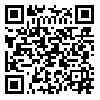Volume 77, Issue 12 (March 2020)
Tehran Univ Med J 2020, 77(12): 740-745 |
Back to browse issues page
Download citation:
BibTeX | RIS | EndNote | Medlars | ProCite | Reference Manager | RefWorks
Send citation to:



BibTeX | RIS | EndNote | Medlars | ProCite | Reference Manager | RefWorks
Send citation to:
Sheikholeslami F, Gharibzadeh S, Gharibzadeh, Miyandehi N, Ahmadnejad F, Godeyri Eslami S, et al . Designing of immuno-capture ELISA assay kit for rabies vaccine potency. Tehran Univ Med J 2020; 77 (12) :740-745
URL: http://tumj.tums.ac.ir/article-1-10211-en.html
URL: http://tumj.tums.ac.ir/article-1-10211-en.html
Farzaneh Sheikholeslami * 
 1, Safoora Gharibzadeh2
1, Safoora Gharibzadeh2 
 , Gharibzadeh2
, Gharibzadeh2 
 , Nargess Miyandehi3
, Nargess Miyandehi3 
 , Farzaneh Ahmadnejad3
, Farzaneh Ahmadnejad3 
 , Saeed Godeyri Eslami4
, Saeed Godeyri Eslami4 
 , Javad Vaez4
, Javad Vaez4 
 , Ali Moradi5
, Ali Moradi5 


 1, Safoora Gharibzadeh2
1, Safoora Gharibzadeh2 
 , Gharibzadeh2
, Gharibzadeh2 
 , Nargess Miyandehi3
, Nargess Miyandehi3 
 , Farzaneh Ahmadnejad3
, Farzaneh Ahmadnejad3 
 , Saeed Godeyri Eslami4
, Saeed Godeyri Eslami4 
 , Javad Vaez4
, Javad Vaez4 
 , Ali Moradi5
, Ali Moradi5 

1- Department of Virology, WHO Collaborating Center for Reference and Research on Rabies, Pasteur Institute of Iran, Tehran, Iran. , f_sheikh@psateur.ac.ir
2- Department of Epidemiology and Biostatistics, Pasteur Institute of Iran, Tehran, Iran.
3- Department of Viral Vaccines, Research and Production Complex of Pasteur Institute of Iran, Karaj, Iran.
4- Department of Quality Control, Research and Production Complex of Pasteur Institute, Karaj, Iran.
5- Department of Health, Safety and Environment, Research and Production Complex of Pasteur Institute of Iran, Karaj, Iran.
2- Department of Epidemiology and Biostatistics, Pasteur Institute of Iran, Tehran, Iran.
3- Department of Viral Vaccines, Research and Production Complex of Pasteur Institute of Iran, Karaj, Iran.
4- Department of Quality Control, Research and Production Complex of Pasteur Institute, Karaj, Iran.
5- Department of Health, Safety and Environment, Research and Production Complex of Pasteur Institute of Iran, Karaj, Iran.
Abstract: (2852 Views)
Background: Potency evaluation of rabies vaccine is a cheap, fast, high precision and consistent with ethical values is critical, so researchers have modified a variety of methods such as: National Institute of Health (NIH) method, Single Radial Immunodiffusion (SRID) and so on. The purpose of the present study was to replace an in vitro method consistent with medical ethics criteria instead of an in vivo method. By recognizing that the potency of the rabies vaccine depends on the amount of glycoprotein antigen content and the monoclonal antibody detect the correct folding of antigen of the rabies virus, then the glycoprotein content could be represent of vaccine potency.
Methods: In this study, we designed an immune-capture enzyme-linked immunosorbent assay (ELISA) with three antibodies (capture, primary and secondary) to determine the existent amount of viral glycoprotein in different rabies vaccines, and compared the results at the same time with measuring potency of those vaccines using the NIH method. This applied study was conducted from September 2016 to September 2018 at the Research Laboratory of the World Health Organization Collaborating Center for reference and research on rabies at the Pasteur Institute of Iran in Tehran.
Results: The slope of the standard line was calculated to R2=0.98 (P=0.0013). In the humans’ vaccines, the mean lied between 5.554-7.336 (SD=0.0463-0.1039) and the coefficient of variation was 0.778-2.436 (SD=0.0041-0.2724), at the same time in the animals’ vaccines the mean were 2.293-5.993 (SD=0.0041-0.2724) and the coefficient of variation was calculated 0.182-4.546. For animal vaccines the Pearson correlation coefficient is 0.99 and for the human vaccines this coefficient was 0.95. Also, the concordance correlation coefficient for animal vaccines was 0.98 and for human vaccines is 0.95, indicating a moderate to high concordance in both animals and humans vaccines.
Conclusion: The designed Immuno-capture ELISA kit had a proper acceptance criterion, intermediate precision, good linearity and robustness for measuring the glycoprotein level of the vaccine, which was directly related to the vaccine potency.
Methods: In this study, we designed an immune-capture enzyme-linked immunosorbent assay (ELISA) with three antibodies (capture, primary and secondary) to determine the existent amount of viral glycoprotein in different rabies vaccines, and compared the results at the same time with measuring potency of those vaccines using the NIH method. This applied study was conducted from September 2016 to September 2018 at the Research Laboratory of the World Health Organization Collaborating Center for reference and research on rabies at the Pasteur Institute of Iran in Tehran.
Results: The slope of the standard line was calculated to R2=0.98 (P=0.0013). In the humans’ vaccines, the mean lied between 5.554-7.336 (SD=0.0463-0.1039) and the coefficient of variation was 0.778-2.436 (SD=0.0041-0.2724), at the same time in the animals’ vaccines the mean were 2.293-5.993 (SD=0.0041-0.2724) and the coefficient of variation was calculated 0.182-4.546. For animal vaccines the Pearson correlation coefficient is 0.99 and for the human vaccines this coefficient was 0.95. Also, the concordance correlation coefficient for animal vaccines was 0.98 and for human vaccines is 0.95, indicating a moderate to high concordance in both animals and humans vaccines.
Conclusion: The designed Immuno-capture ELISA kit had a proper acceptance criterion, intermediate precision, good linearity and robustness for measuring the glycoprotein level of the vaccine, which was directly related to the vaccine potency.
Keywords: enzyme-linked immunosorbent assay, National Institutes of Health (U.S.), rabies virus glycoprotein, vaccine potency
Type of Study: Original Article |
Send email to the article author
| Rights and permissions | |
 |
This work is licensed under a Creative Commons Attribution-NonCommercial 4.0 International License. |



